“so that not only this our craft is in danger to be set at nought; but also that the temple of the great goddess Diana should be despised, and her magnificence should be destroyed, whom all Asia and the world worshippeth.”
Acts 19:27 KJV
The earliest stories of candles and cakes are linked to the ancient Greeks. Once a month, they would celebrate the birth of Artemis, goddess of the moon by making round cakes. Lit candles would be placed on the cake to represent a glowing moon and their smoke would carry wishes and prayers to the sky-dwelling gods.
The History of the Birthday Cake
Cultures have been creating celebratory ‘cakes’ (the term cake and bread were often interchangeable) for thousands of years. However, cakes, specifically for birthdays, similar to what we enjoy today, are believed to have originated in Germany in the 1400’s. Before that time, cakes were almost solely for the celebration of weddings but bakeries began to market them for birthdays as well.
Until the industrial revolution, birthday cakes were almost exclusively for the wealthy, as they were able to afford such extravagance. The industrial revolution helped to spread birthday cakes to the public as the advancement and proliferation of technology and materials made them cheaper and more easily produced.
Like cakes themselves, the tradition of lit candles adorning a cake goes back thousands of years, but did not necessarily become associated with birthdays until much later.

In Ancient Greece, Artemis was the goddess of the hunt, as well as the moon (Her twin brother, Apollo, was god of the sun). It is said that cakes brought to the temple of Artemis were adorned with candles to make them glow like the moon. Many ancient cultures and many religions also believed that smoke was a vehicle to carry prayers up to the gods, and it is possible that this idea is the basis for our modern “make a wish” tradition.
As with the marketing of birthday cakes, the addition of candles is also attributed to the Germans around the 1700’s when Kinderfesten, birthday celebrations for children, became more common. The custom was to place a candle for each year of their life as well as extra candles to represent years to come.
Putting candles on cake was a Greek innovation
In Ancient Greece, worshippers brought moon-shaped cakes to the temple of Artemis, the goddess of the moon and the hunt. The cakes were decorated with lit candles in order to make them glow like the moon.
The Romans baked the first birthday cakes
They made cakes of flour, nuts, yeast, and honey to celebrate weddings and the occasional 50th birthday (only if the birthday boy was a famous citizen, and women's birthdays weren't celebrated anywhere until the 12th century).
Kids' birthday parties became a thing in Germany
The Germans probably first celebrated birthdays in a manner similar to how we do today. In the 18th century, Kinderfeste (which sounds like a great name for a German theme park) was a party held for a child. In the morning, a cake was topped with lit candles. The child did not blow them out, though. Instead, they were left to burn all day until after dinner, when the cake was eaten.
The earliest known account of a ceremony that resembles a classic birthday celebration comes from the Greek historian Herodotus (5th century BCE). He wrote about the Persians and how they loved to celebrate their birthdays which were presumably accompanied by cake eating.
“Of all the days in the year, the one which they celebrate most is their birthday. It is customary to have the board furnished on that day with an ampler supply than usually. The richer Persians are served with a whole-baked ox, horse, camel or an ass.
The lower social ranks have the smaller kinds of cattle. They hardly ever eat full-course meals but an abundance of side dishes, set on the table in few dishes at a time. This is the reason for the saying that “When the Greeks eat, they leave off hungry and nothing is worth mentioning to them after the meats; If someone keeps on putting more food in front of them, they wouldn’t stop eating”.
Another early mentioning of a ritual similar to a birthday party comes from the Book of Genesis (40:20-22)
20 And it came to pass the third day, which was Pharaoh’s birthday, that he made a feast unto all his servants: and he lifted up the head of the chief butler and of the chief baker among his servants.
21 And he restored the chief butler unto his butlership again; and he gave the cup into Pharaoh’s hand:
22 But he hanged the chief baker: as Joseph had interpreted to them.
The event described above refers to the Pharaoh’s coronation and his rebirth as a god instead of his actual birth. Whatever the case, this sounds like a bad party, with the baker being hanged, probably because he didn’t make a cake…
The fire has always contributed to rituals. No wonder birthday candles have been attributed with granting wishes. Candles are often used during meditations, in general.
The Ancient Greeks used to give the goddess Artemis a cake with candles as an offering. Artemis ruled over the Moon, so the cakes were often shaped like this celestial body. They believed that the candle smoke would help Artemis hear all the prayers while they ascended to her domain.
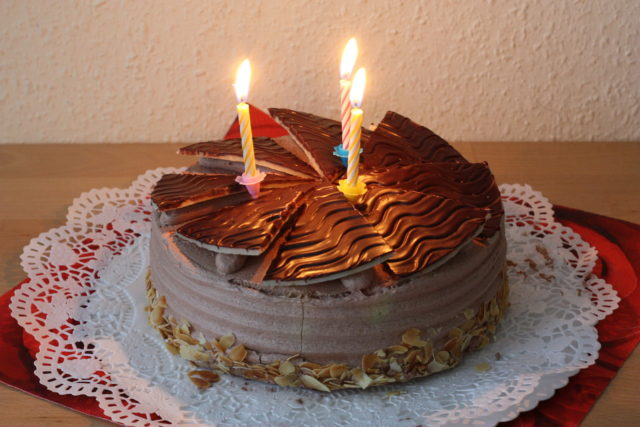
In Ancient Rome, birthday celebrations were nobles’ privilege. When somebody from the higher ranks of the Roman society turned 50, considered as a significant milestone in life, it was common for his friends and family to throw that person a party (feast) and surprise them with a nice, sweet cake. However, in Rome, the cake was served without candles.
During the Middle Ages, birthdays weren’t celebrated mostly because of the early Catholic beliefs that these celebrations are pagan and pose a threat to Christianity.
Besides all of the above-mentioned ancient rituals which are similar to birthday celebrations, here’s an actual reference to modern birthdays and birthday cakes! German bakers from the 15th century started selling special one-layer birthday cakes, mostly to parents who were celebrating their children’s first birthday.
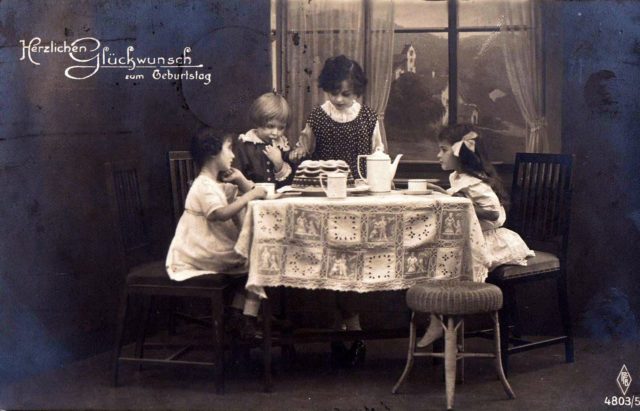
Further evidence shows that this tradition continued up until 18th-century Germany when candles were also added to the cakes. This version of the birthday celebration was called Kinderfest (children’s festival). This tradition was the predecessor of modern children birthday party.
During Kinderfest, children were taken to a ceremony hall where they were free to celebrate their birthday. Germans believed that evil spirits could steal people’s soul during birthdays.
To protect the person celebrating, they used to make a circle around him and carouse. Gifts were not a birthday tradition back in those days. It was enough if the guests expressed their good wishes for the person that was celebrating. In case somebody brought a gift it was considered as a good sign for the upcoming year of the birthday person.
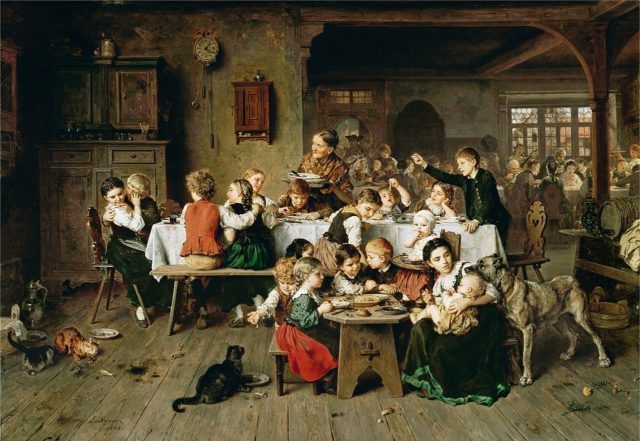
Now let’s get back to the cake and candles. One of the earliest records of candles used on a birthday cake dates from 1746 when a large celebration was held for Count Ludwig von Zinzendor’s birthday. One of his guests described the following:
“There was a cake as large as any oven to bake it in, and holes made in the cake according to the years of the person’s age, each one with a candle stuck into it, and one in the middle”.
Almost 50 years later, Prince August of Saxe-Gotha-Altenburg described his own birthday party:
“…a generous-size torte with colorful flaming candles – amounting to some fifty candles – that began to melt and threatened to burn down, instead of having enough room for candles which indicate upcoming years, as in the case with children’s festivities”.
These notes show that according to the old tradition, there were candles for each year of the person’s life. Besides this, more candles were added to mark the upcoming years of the person.
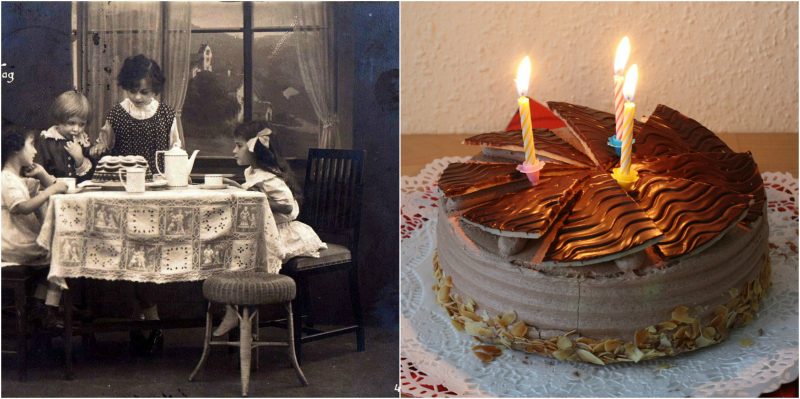
Why Candles?
To the ancient Greeks, birthday candles had special magic for granting wishes. That’s why children today make a wish before blowing out the candles.
Why Cake?
Birthday cakes also started with the ancients. Roman Emperor Hadrian sent cakes by special messengers to invited guests unable to attend his birthday celebration.
Sending Cards
Birthday cards first turned up in England and America about 1850, shortly after the first Christmas cards.
Have A Party!
Birthday parties started with the German kinderfeste, or children’s festival. In Holland, children make up a verlanglijst, excitedly jotting down all the presents they want.
The Russians have pie almost as often as cake, Icelanders go for canned fruit, and the Danes hang a flag out the window on a birthday.
The global tradition of blowing out candles which adorn a birthday cake to be shared with well-wishers might be rooted in an ancient Greek votive ritual to honor the goddess Artemis, the female archetype associated with childbirth, wildlife, and the moon.
The Ancient Greeks started making cakes that were modeled after the moon as tribute to Artemis, the goddess of the moon. The cakes were circular and then lit with candles to shine like the moon, notes Columbia Daily. Tradition tells us that a long-lost connection with devotional cakes to Artemis may survive today as part of the most popular celebratory habit in the Western world and beyond.
The goddess of childbirth
Although referred to as a consecrated maiden, like fellow goddesses Athena and Hestia, Artemis was worshipped as one of the primary goddesses of childbirth and midwifery.
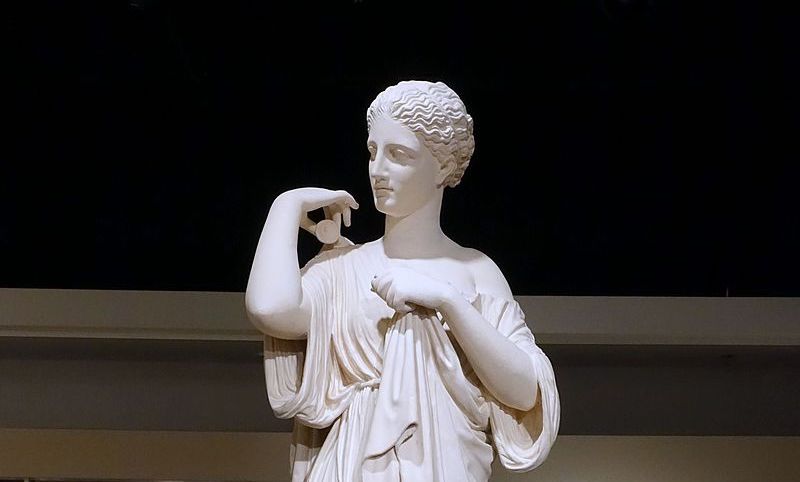
Deaths during pregnancy were attributed to her, and dedications of clothing to her sanctuaries after a successful birth were a common habit in the Classical era, according to Susan Wise, PhD, the author of “Childbirth Votives and Rituals in Ancient Greece.”
The Greek poet Callimachus in his “Hymn to Artemis” recites how the young goddess asked her father, Zeus, among other things, to offer her the ability to help women in the pains of childbirth.
Several festivals were devoted to Artemis throughout the year in ancient Greece. During the feast called Elaphobolia, celebrated in March and April of every year in Athens and Phocis, the goddess was offered cakes shaped like deer, one of her sacred symbols. According to the ancient historian Pausanias, these were called ‘elaphos,’ the Greek word for deer.
During the second festival, a cake was offered as part of a ritual by young men and women reaching puberty in the area where Mikrolimano is today.
Ancient Greek “ammilos” may be first birthday cake in Greece
The most interesting tradition in relation to birthday cakes as we know them today, however, is the so-called ammilos votive cake. Its speculated etymology is probably the strongest link we can obtain with the contemporary symbolism of the birthday cake.
In another festival devoted to Artemis, the Mounikhia, she was offered cakes made from dough, honey, and sesame seeds. The cakes were taken to the temple where they were presented between two burning torches, called “amphiphontes,” representing the East and the West; this was yet another representation of Artemis as a moon goddess, as the round cake of the moon was between flames, representing the setting and rising sun.
As the owners of the Greek cooking and pastry academy Ammilos state, “The ancient Greeks accompanied the celebration of the completion of an additional year of life with a sweet, dedicated to the Goddess Artemis, named ammilos.”
Candlelight symbolized stars and the moon
The owners state that our typical birthday celebrations have roots tied back to these rituals “with the singing, burning candles and extinguishing [the candles] at the end of it.” The candles that were placed in the sweet in order to glorify the goddess symbolized the stars and the moon, which were associated with the goddess of hunting.
“Then,” it is said, “the cake was transferred to the temple of Artemis, and there, after they made a wish, [they] put out the candles, believing that the smoke carries the prayers to the heavens.”
Although cakes, especially ceremonial, did exist in other ancient civilizations, such as Egypt and China, it is considered that cake making—like so many other concepts—was passed to the Romans and the Western world through the Greeks.
In the original text of Deipnosofistes, there is an extensive list of all cake-making in Greece and the colonies, stating that bakers on Samos were masters in cake-making while in Sicily, they made local variations of the confection.
All cakes there were called “plakountes” (flat-tops) and were made from wheat, cheeses, honey, and nuts. Some were made in layers, such as today’s elaborate pastries in Greece.
Written references to the tradition of blowing out the candles were first documented in Switzerland’s Folklore Journal in 1881 where there is a depiction of a birthday cake as having lighted candles which correspond to each year of life. These candles were required to be blown out, individually, by the person celebrating his or her birthday.
Ancient Rome borrowed many customs from Greece
It certainly wasn’t just the ancient Greeks who celebrated milestones with sweet cakes, however. Ancient Rome also had their traditions, and it’s believed that the original birthday cake originated from their celebrations after they adopted it from the Greeks.
Rather than just celebrating birthdays, though, ancient Romans were known for celebrating all things with cake, including weddings. Birthday cakes, made with honey, flour, nuts, and yeast, commemorated only birthdays of high-ranking men who were well-regarded citizens of Rome.
As a rule, it was men’s 50th birthdays which were most often celebrated there. According to information from the magazine Food & Wine, birthdays of females were not celebrated until the 12th century in Europe. Many centuries later, children would be the first to have their birthdays celebrated in what is now Germany during the Middle Ages.
Fortunate children there enjoyed birthday cakes that resembled those of the ancient Greeks with the exception of the birthday candles. Rather than adding them at the edges of the cake, as had been the case in propitiations to the goddess Artemis, candles were added for each year of the child’s life.
Birthdays celebrated around such cakes, which had a candle for each year of their age plus one for the future, were called Kinderfeste. Oddly enough, however, the Kinderfeste cakes were given to the children on the mornings of their birthdays with the candles lit, and they were not blown out until after dinnertime.

No comments:
Post a Comment